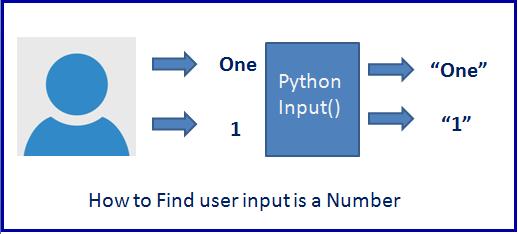In this lesson, you will learn how to check user input is a number or string in Python. We will also cover how to accept numbers as input from the user. When we say a number, it means it can be integer or float.
Understand user input
Python 3 has a built-in function input() to accept user input. But it doesn’t evaluate the data received from the input() function, i.e., The input() function always converts the user input into a string and then returns it to the calling program.

Let us understand this with an example.
Output Enter number and hit enter 10 Printing type of input value type of number class 'str'
As you can see, The output shows the type of a variable as a string (str).
Solution: In such a situation, We need to convert user input explicitly to integer and float to check if it’s a number. If the input string is a number, It will get converted to int or float without exception.
Convert string input to int or float to check if it is a number
How to check if the input is a number or string in Python
- Accept input from a user
Use the
input()function to accept input from a user - Convert input to integer number
To check if the input string is an integer number, convert the user input to the integer type using the
int()constructor. - Convert input to float number
To check if the input is a float number, convert the user input to the float type using the
float()constructor. - Validate the result
If an input is an integer or float number, it can successfully get converted to
intorfloattype. Else, we can conclude it is a string
Note: If an input is an integer or float number, it can successfully get converted to int or float, and you can conclude that entered input is a number. Otherwise, You get a valueError exception, which means the entered user input is a string.
Program :
Output Enter your Age 28 Input is an integer number. Number = 28 Enter any number 3.14 Input is a float number. Number = 3.14 Enter the last number 28Jessa No.. input is not a number. It's a string
- As you can see in the above output, the user has entered 28, and it gets converted into the integer type without exception.
- Also, when the user entered 3.14, and it gets converted into the float type without exception.
- But when the user entered a number with some character in it (28Jessa), Python raised a
ValueErrorexception because it is not int.
Use string isdigit() method to check user input is number or string
Note: The isdigit() function will work only for positive integer numbers. i.e., if you pass any float number, it will not work. So, It is better to use the first approach.
Let’s execute the program to validate this.
Output Enter number and hit enter 45 User input is Number Enter number and hit enter 45Jessa User input is string
Also, If you can check whether the Python variable is a number or string, use the isinstance() function.
Example
Only accept a number as input
Let’s write a simple program in Python to accept only numbers input from the user. The program will stop only when the user enters the number input.
Output Please enter a number 28Jessa This is not a number. Please enter a valid number Please enter a number 28 Input is an integer number. Input number is: 28
Practice Problem: Check user input is a positive number or negative
Show Solution
Next Steps
Let me know your comments and feedback in the section below.
Also, Solve:
